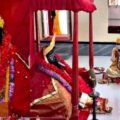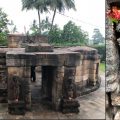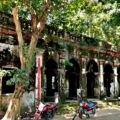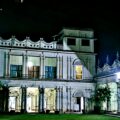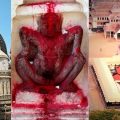The Six Shakti Peeths of Bangladesh: An Account
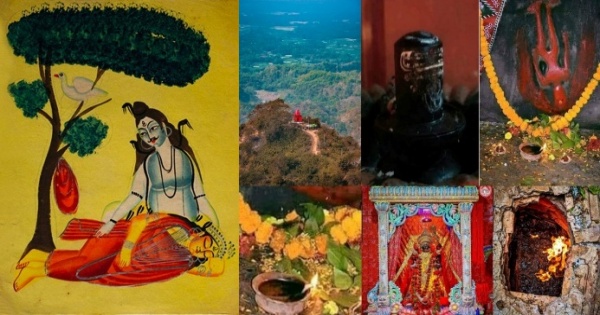 Shakti Peeths are holy places or pilgrimage sites in Hinduism pertaining to Goddess Sati. According to Puranic history, some thousands of years ago, there was a king in the Himalayan region named Daksha whose daughter was Sati. When Sati grew older, she performed intense penance to attain Lord Shiva as her husband. Against Daksha’s wishes, Sati married Shiva. Once Daksha performed a Yajna; he invited all the gods and goddesses except Shiva and Sati. Sati insisted on attending the function despite the disapproval of Lord Shiva.
Shakti Peeths are holy places or pilgrimage sites in Hinduism pertaining to Goddess Sati. According to Puranic history, some thousands of years ago, there was a king in the Himalayan region named Daksha whose daughter was Sati. When Sati grew older, she performed intense penance to attain Lord Shiva as her husband. Against Daksha’s wishes, Sati married Shiva. Once Daksha performed a Yajna; he invited all the gods and goddesses except Shiva and Sati. Sati insisted on attending the function despite the disapproval of Lord Shiva.
When Sati entered Daksha’s palace, the latter insulted her. He said that his other daughters were more distinguished and worthy of honour than Shiva and Sati. Sati could not bear Daksha’s insulting words for her husband, Shiva. She threw herself in glowing sacred fire and Daksha Yajna was deserted. When news reached Lord Shiva, he was enraged. He created a fierce giant named Veerbhadra from his matted hair and ordered him (Veerbhadra) to go and destroy the Yajna of Daksha. Veerbhadra rushed to the sacrificial area and severed the head of Daksha. However, it was proclaimed that the Yajna should not be left incomplete. So, a head of goat was placed to restore Daksha’s life.
Shiva began to wander around, carrying the burnt corpse of Sati. He started Pralay Nritya (the dance of destruction of universe.) In order to save universe and break this attachment of Lord Shiva, God Vishnu with his Sudarshana Chakra cut Sati’s body into pieces. Sati’s body pieces fell at 51 different places; these emerged as pilgrimage sites and are called Shakti Peeths.
Although there are generally 51 Shakti Peeths, there is disagreement in the scriptures about the number of the shrines. According to Peethanirnaya Tantra, it is 51. These Shakti Peeths are located in various parts of the Asian subcontinent with the highest in Bharat. Out of fifty-one, six are located in different areas of Bangladesh, three in Pakistan, three in Nepal, and one each in China and Sri Lanka.
The six Shakti Peeths of Bangladesh are Jessoreshwari at Shyam Nagar Upazilla of Shatkhira District, Sugandha at Barishal, Jayanti at Kanaighat in Sylhet, Bhabani at Sherpur Upazilla in Bogra, Chandra Nath at Sitakunda in Chittagong and Sri Sri Mahalaxmi Bairabi Griba at Dhakkin Surma Upazilla in Sylhet district.
Jessoreshwari Shakti Peeth at Shyam Nagar, Shatkhira District
Jessoreswari represents the site where a palm of Sati fell. The name ‘Jessoreswari’ means ‘Goddess of Jeshore’. According to historical records, the General of Maharaja Pratapaditya discovered a luminant ray of light coming from the bushes. He came upon a piece of stone carved in the form of a human palm. Later, Pratapaditya started worshiping Kali at the spot where the carved stone was discovered. He built the Jessoreswari Kali temple at the spot. The temple was named after Jessore.
Jessoreswari Kali shrine is believed to have been created by a brahmin named Anari. He created a 100-door temple for the Goddess. But the timeline is not known. Later it has been renovated by Lakshman Sen and Pratapaditya in their reigning periods.
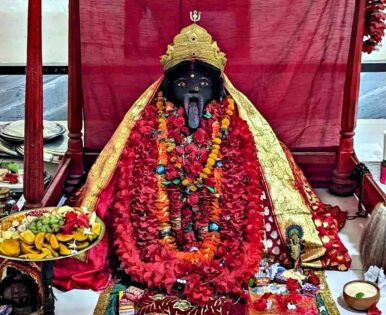
The temple is visited by pilgrims from all over the world, irrespective of sectarian differences. Worship is done by the priest every Saturday and Tuesday at noon time. But before 1971, there was a daily routine of worship. Every year on the day of Kali puja, the present Caretakers of the temple conduct a ceremony. There is also a mela that takes place around the temple compound. Indian Prime Minister Narendra Modi visited the Jessoreswari Kali Temple on March 27, 2021.
A large rectangular covered platform called Natmondir has been erected adjacent to the main temple, from where the face of the goddess can be seen. This was renovated by Laxman Sen in the late 13th century, but the builders are not known. After 1971, it crumbled. Now only the pillars can be seen.
Jayanti Shakti Peeth at Bauorbag Village in Kanaighat, Sylhet
The Jayanti Shakti Peeth is located around 55 km away from Sylhet divisional headquarters in Bangladesh. It’s believed that left thigh of Sati fell in this holy place. The temple is spread over 5.90 acres of land. There is a kund (pond) in the temple premise.
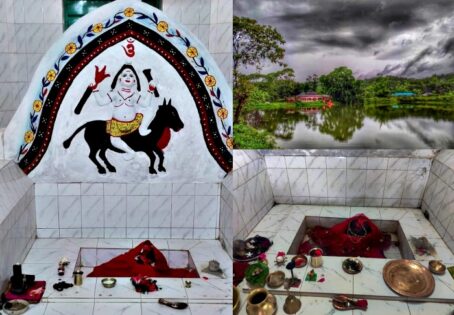
Some local miscreants have been encroaching the bank of the temple pond for a long time. According to the temple management and other local residents, about one and a half acres of land has been grabbed.
Chandra Nath Shakti Peeth at Sitakunda, Chittagong
Chandra Nath temple is located on top of the 350 metres high Chandranath hill at Sitakunda in Chittagong of Bangladesh. As per Hindu sacred texts, the right arm of Goddess Sati fell here. This shrine is one of the 51 Shakti Peeths.
There are two Moortis here, one is of Devi Sati and called as Bhavani. The other Moorti in this temple is of God Shiva Known as Chandrashekhar. This particular word is depicted for all those individuals who have got a moon at the crown or at the top of their head. As per the belief of many local people, Shiva himself has committed to visit Chandrasekhar hill during Kali Yuga. The temple is beautifully made with marble structures and art.
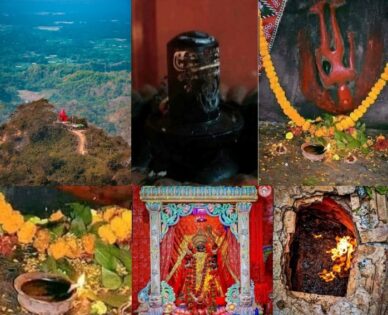
At present, some religious zealots attempted to desecrate the sanctity of this oldest pilgrimage site of the Hindus. There are reports of various incidents happening here. In 2021, a young man climbed to the top of the temple and performed azan; he posted it on his Facebook ID. When there was a big storm on social media about this, the police arrested the two youths. Another post on Facebook about organizing a barbecue party has been reported, which created a lot of uproar. Besides, a clash occurred between Hindu devotees and non-Hindus near the temple, leading to the injury of at least 10 people. The Daily Chattragram Protidin and Amader Somoy covered a news in this regard, but top level online news portals, print and electronic media remained silent to cover the report in this connection. Recently, a team of ISKCON Bangladesh led by Chinmoy Krishna Das Prabhu, President of ISKCON Sri Sri Pundrik Dham visited Chandra Nath Shakti Peeth following the recent situation.
Sugandha Shakti Peeth at Shikarpur Village, Ugirpur, Barishal
This Shakthi Peeth is situated on the Sunanda River’s banks located 21 km away from Barisal City town. Residents affectionately referred to this temple as Shikarpur Tarabari. The whole temple complex is made of stone, with images and statues of gods engraved on them. This temple has been destroyed several times and has undergone considerable renovations over time.
Maa Sati’s nose is reported to have fallen here. She is known as ‘Sunanda’ and Shiva is known as ‘Traimbak’. Ponabalia, 5 miles south of Jhalkati rail station, still has the Bhairav temple. Ponabalia is located on the Sunanda River’s bank, beneath the Shamrail settlement.
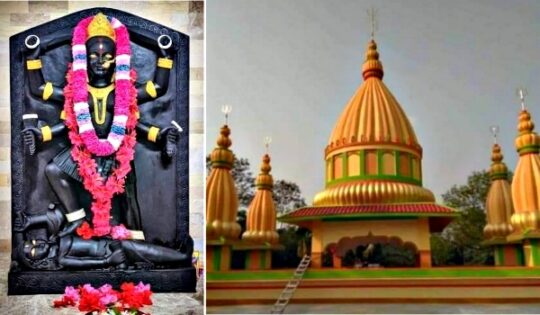
There is no precise information about the construction or establishment of Sugandha Shakti Peeth. However, based on the temple’s appearance, it is clear that it was built in the very distant past. The temple was recently rebuilt, and the Moortis are now housed in the newly renovated temple. According to Agama Shastra, the shadow of the temple should not fall over moving water. This is one of the rare temple’s where the temple’s shadow falls on the Sunanda River. Sati here is worshipped in the form of a small stone Moorti.
The temple also has a large kund (pond), which is considered to be holy. Devotees take a dip in the pond before entering the temple as it is believed to cleanse the body and purify the mind. One famous festival that is celebrated with great enthusiasm and devotion is the ‘Shiva Chaturdashi’ in March.
Sri Sri Mahalaxmi Bairabi Griba at Jaipur, Dhakkin Surma, Sylhet
Here Devi Sati’s name is Mahalaxmi, and Bhairav’s name is Sambharanand. According to belief, the Sanskrit term griba, meaning neck or throat of Sati had fallen at this place – one of the 51 Shakti Peeths. The shrine is thus also known as Griba Peeth. It is also claimed that the Sati’s seven aaparnas (jewels) also fell around this site; these places are known as saptha mathas. Some say kandta or hatta means neck, and Sreehatta is now known as Sylhet. Sreeshail means hill in Sanskrit and is today known as Sylhet.
Sati’s griba fell on a rock, which was then worshipped during ancient times. Later the rock remained hidden for a long time. Between the twelfth and thirteenth centuries, the road around this site was being repaired. During the repair work under Deviprasad, the labourers discovered a rock, especially while digging the ground. Nothing could move that rock from that place. A worker happened to break the rock in two with a sable. Immediately, a girl appeared from the nearby forest and slapped the worker and then disappeared in front of everyone. That night, the Goddess appeared in the dream of Deviprasad and told him to install Her at that place and make arrangements for daily worship.
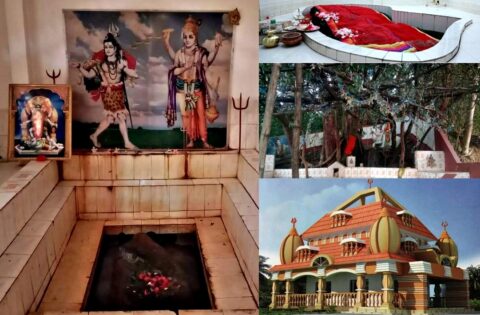
Deviprasad made arrangements to build a temple of the Goddess with lakhs of bricks. But the next night, the Goddess appeared in his dream again asking him to build an open temple, not a closed one. Deviprasad covered the surrounding rock with bricks. Even today, the descendants of Deviprasad are engaged in the maintenance of the temple. This temple is still open from above.
Like Devi, Bhairava Sarbananda was at first hidden here. No one knew about Bhairava’s whereabouts. One day a great saint Brahmananda came to Giri Srihatta and attained siddha after worshipping the Goddess. Through his sadhana, the sadhaka came to know that to the west of Goddess Mahalaxmi was Shiva on a hill. One day, late at night, the saint took his disciples up the hill and told them that this was the place where the God Bhairava rested. Unfortunately, in 1281 Brahmananda Giri breathed his last without rescuing Bhairava.
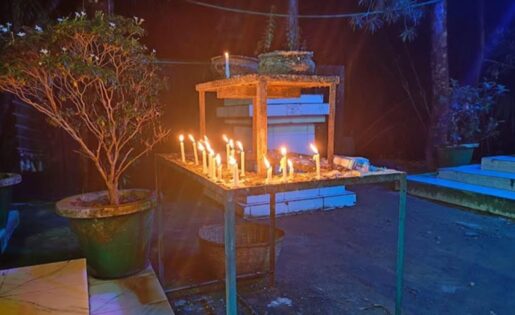
Acharya Sankara, a disciple of Brahmananda Giri, was from the Ten Names sect. In his dream, in 1286 in Magha month of the Hindu calendar, he saw his Guru Brahmananda Giri climbing the Shiva mound with two disciples saying, “Here is the place of the god. I will reveal him”. Then the Shivalinga was found after digging the ground. The disciples were Kailas Chandra Bhattacharya and Krishna Kumar Bhattacharya. Co-incidentally, the two disciples visited his house. They also saw the same dream. All three disciples of Brahmananda Giri witnessing the same dream on the same night made them visit the hill. Upon digging, they found the Shivalinga along with Gauripatta. The residents gathered and worship of Shiva thus began thence.
It’s learnt that a huge chunk of land of this temple was occupied by miscreants, especially from 2003 to 2010. They tried to grab the land of the temple.
Bhabani Shakti Peeth at Bhabanipur Village in Sherpur, Bogra
Bhabani temple is spread over four acres of lush green area with Bhabanipur Bazar on one side and two schools – a high school and a government primary school on the other side. The site comprises of the main temple dedicated to Goddess Bhabani and several more shrines of Shiva, Patal Bhairav (Vaman), Belbaran Tala, Shakha kund, a Sevangan, a Gopal temple, a Vasudev Temple, a Nat Mandir and on the extreme north, a Panchamunda Asana Moorti.
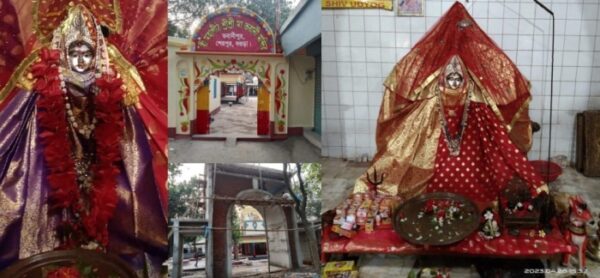
The form of Shakti worshipped at Bhabani Shakti peeth is called Arpana and the Moorti is symbolic of Sati’s left anklet. The Bhairava who protects the anklet is Vaman, and is said to be a manifestation of Shaivite energy. Alternatively called Aparna, Bhavani and Tara, the Deity has several legends associated with Her. Etymologically, ‘Bhabani’ or ‘Bhavani’ means one who rules the universe. ‘Arpana’ means one who is dedicated to Shiva and ‘Aparna’ refers to one who is so lost in worship that even the falling leaves go unnoticed. Goddess Kali is worshipped in this temple.
There are several more legends associated with this Peeth. It is said that the King of Nator and his grandson the Maharaja Ramkrishna used to meditate near this temple. The seat, the yagna kunda and the five skulls they famously worshipped are still present at the site. There is another popular legend which is the source of the name Shakha kund – the Pond of the Conch Bangles. Once, a poor seller of conch bangles met a little girl near the temple who asked for some conch bangles. Charming and full of life, she asked the bangle-seller to collect the money for the bangles from the Rajbari which he agreed to do. When the queen Rani Bhavani heard about this incident, she went to the place herself, for there were no little girls in the royal family at that time. The bangle-seller realised she was none other than the goddess Bhavani and began praying to her. The goddess soon emerged from the waters of the pond with her arms full of conch bangles and blessed everyone.
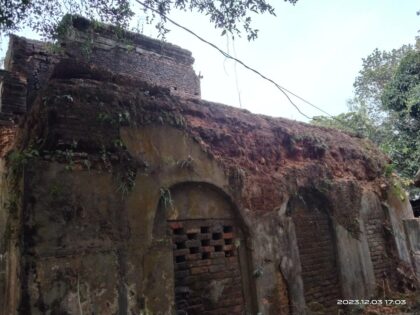
On 14 August 2014, a top ranking vernacular newspaper named The Daily Prothom Alo covered an article on this historical pilgrimage site stating that about 300 bighas of land which was in the name of the temple was grabbed and litigation also going on about that. It’s difficult to recover the occupied land. However, the devotees are hoping that the government will help in the renovation of this ancient structure and religious holy place.
Featured image: Extreme left image from Google; rest of Shakti Peeths collage by author. All other images in article body by author.
Facebook Comments Box
The following two tabs change content below.

Sangram Datta
Sangram Datta is a history enthusiast from Bangladesh.

